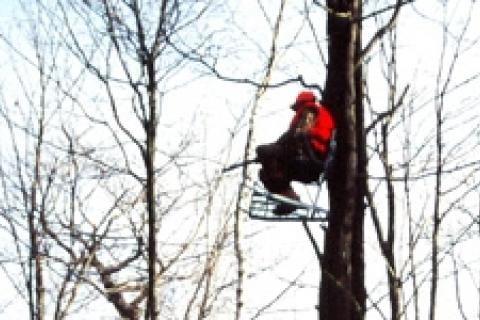
 Every year more hunters in North America are killed or injured from falling out of a treestand than are injured through shooting accidents. This is despite the fact that the Treestand Manufacturers Association (TMA) and its members do a great job in educating hunters on the safe use of treestands and safety equipment. In fact, the TMA has some great safety tips on its website. I encourage you to read those so I won't repeat them here, but instead offer my own additional tips learned over many years, and a few close calls.
Every year more hunters in North America are killed or injured from falling out of a treestand than are injured through shooting accidents. This is despite the fact that the Treestand Manufacturers Association (TMA) and its members do a great job in educating hunters on the safe use of treestands and safety equipment. In fact, the TMA has some great safety tips on its website. I encourage you to read those so I won't repeat them here, but instead offer my own additional tips learned over many years, and a few close calls.
- You must be tethered in some fashion at any time you don't have at least one foot on the ground. Too many people wait until they are actually in the treestand before securing themselves. That won't help you if you fall during your climb. Several manufacturers offer climbing belts or tether lines for their safety harnesses. Use one.
- Trim all limbs up to our stand. That is the only way to ensure that your climbing belt will work properly and won't get caught on anything on the way up/down.
- Whether you use screw-in tree steps or climbing sticks, make sure that the lowest step is low enough so that you don't have to stretch to reach it going up, or have to jump down when descending. Similarly, place steps a comfortable distance apart up the tree. The further you have to reach for one, the greater the chance of a fall.
- Place your highest step at least at or preferably just slightly above the level of the platform of your treestand. You should be able to comfortably step over and back from your stand, rather than having to climb into it.
- Even if you use climbing sticks, carry a screw-in step in an easily accessible pocket. Should you fall and be hanging out of reach of your climbing sticks/steps, you can attach it to the tree and use it to relieve the tension from your suspension device and climb back onto your steps.
- Don't try to ascend/descend in the pitch dark. Use a flashlight or preferably a headlamp to see your way up or down. It's too easy to miss a step and slip when you can't see well.
- Some safety systems utilize a tree strap and carabiner to connect the harness to the tree. If you hunt out of multiple treestands, purchase extra straps and carabiners so that you can leave one rig attached to each tree you may use. That way you can quickly connect your harness as soon as you get into your stand, instead of having to fumble in the dark and cold trying to thread your harness strap through the tree strap prior to attaching to the tree.
- A small piece of carpeting attached to the platform of your treestand can not only make it quieter and warmer on your feet, but will reduce the chance of you slipping off the platform in wet conditions.
- If you are over-tired, or when the weather is bad, whether heavy rain or snow, high wind or lightning, stay out of a treestand. The danger of treestands and climbing into them is increased multi-fold under such conditions. If you must hunt at all, say on the ground.
- It's amazing what you can forget in a year, so make sure you re-familiarize yourself with how to use both your treestand and your safety harness before the start of each season. At least re-read the manual, but preferably watch the safety video that now comes with many of the new models.
Good hunting.
- 5496 views

